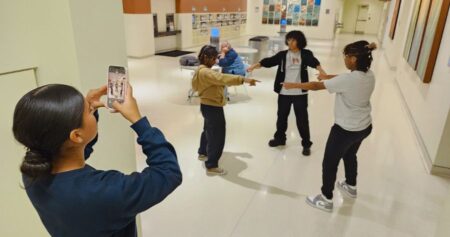Social media and its impact on students can be a contested topic. Criticisms of student use of social media abound, and many of them are valid–but the conversation often overlooks a crucial distinction: the difference between passive consumption and active creation. When it happens in a structured and supportive learning environment, student content creation can enhance learning in incredibly meaningful ways. It also gives students a chance to express themselves, advance ideas, advocate for causes, and explore their passions with guidance from teachers and administrators. Here’s a deeper look at how social media content creation can help students build invaluable skills and experience for continuing education, the workforce, and beyond.
Creation vs. Consumption
When students are challenged to create content, their experience with social media transitions from consumption to creation. Consumption is a passive act, while creation is actively strategic, forcing students to think critically about their goals and employ their skills and knowledge in order to convey visual and written information in a way that achieves those goals.
When students are tasked with creating content, they must think about the goals of their work. Are they trying to synthesize information, provide an informative update, or perhaps get people involved in a meaningful cause or event? When students are tasked with creating content for school social media channels around these efforts, they activate critical thinking, creativity, and skilled like writing, argument building, rhetorical analysis, photography, branding, and design. Through content creation, students learn to express themselves while engaging with their peers and community in a meaningful way. Not only enhancing their learning experience but also building their confidence and self-efficacy—key factors in academic success.
In short, student content creation has the power to turn social media from a distraction into a powerful learning tool–especially when it is deployed within a learning framework with specific goals and oversight (such as in the classroom or through a school social media team or club).
Educators can also carefully structure and monitor content creation in the classroom. Social media management platforms designed specifically for this purpose Certain platforms designed specifically for education make it so students can produce content without direct access to social media platforms. This addresses concerns about online safety while still providing students with hands-on experience in the creation process, all under the watchful eye of educators.
The Pedagogy of Student Content Creation
Beyond skill building and empowering student voice, creating in-school or extracurricular opportunities for students to create social media content is a powerful way to bridge the gap between understanding and application through authentic assessment. When educators task students with creating social media content, they’re not just passively absorbing information—they’re actively processing it, synthesizing it, and presenting it in a way that’s engaging.
Educators can easily incorporate content creation assignments into a variety of existing courses using research-based education strategies. English, journalism, graphic design, multimedia, marketing, and business courses, just to name a few, all inherently lend themselves to the skills learned through content creation. Unlike regular tests, these projects make students use what they’ve learned to create publishable work, like captions, graphics, or photo and video content. It provides a more comprehensive picture of students’ capabilities, allowing educators to evaluate not just what students know, but how they can apply that knowledge in real-world contexts.
The Value of Digital Citizenship Education
Teaching digital citizenship in schools is crucial, and using content creation is a great way to include these lessons in the curriculum. Digital citizenship teaches students how to contribute online responsibly, ethically, and safely. As consumers of online media, students will inevitably encounter challenges such as online scams, misinformation and disinformation, privacy concerns, and even legal challenges. Students also need to understand the extent of their digital footprint and the way the things they say and do online can reach peers, future employers, educational institutions, or people who threaten their safety.
It’s not just about students protecting themselves online; digital citizenship skills also include understanding how to engage respectfully and constructively in digital spaces. The good news? Practice makes perfect. When schools provide structured opportunities for students to engage online, create and distribute branded content on behalf of their school or various clubs and groups within their school, they gain a broader and more applicable understanding of what it means to be a good digital citizen. Real-world learning at its finest!
Amplifying Student Voice
Social media is a great outlet for educators to provide students with a sense of agency and empowerment. Through content creation, they can share their own stories and experiences in a supportive and safe environment. Seeing their content published builds students’ self-efficacy by reinforcing their belief in their ability to succeed. The process of receiving feedback and being able to improve their work before publishing helps develop a growth mindset, giving students an edge in future roles.
Student storytelling is not just beneficial for the students themselves—it also has a significant positive impact on the school community. Sharing school content from the perspective of students living the experience is inherently more authentic and engaging, in turn benefitting the school/district This builds goodwill among the community and can play a crucial role in student retention, recruitment, and fundraising initiatives.
By embracing student-led social media, schools can provide a more engaging approach to education that provides students with tangible skills through real-world learning opportunities. In doing so, we’re not only preparing our students for the future—we’re empowering them to shape it.
Get your Students Involved
Class Intercom’s Content Generation Workshop is an annual event happening in October. It’s an excellent way for students and educators alike to experience the impact of student content creation through a day of hands-on student learning about and through social media content creation. Whether attending in person, at a satellite location, or virtually, the event offers a unique opportunity for student content creators nationwide to connect, network, and collaborate in real-time. Learn more and get your student teams registered using the link below.
